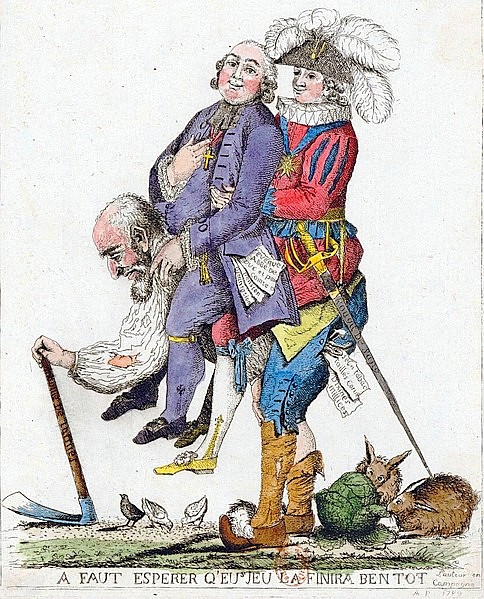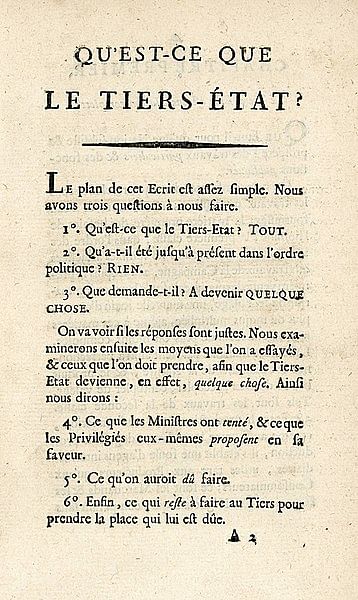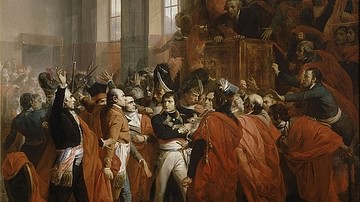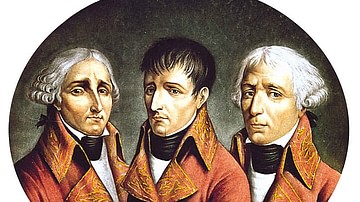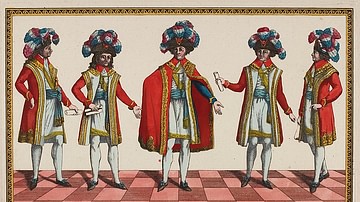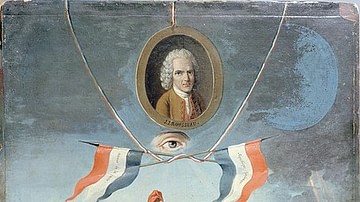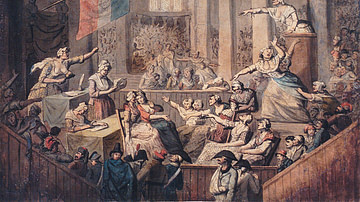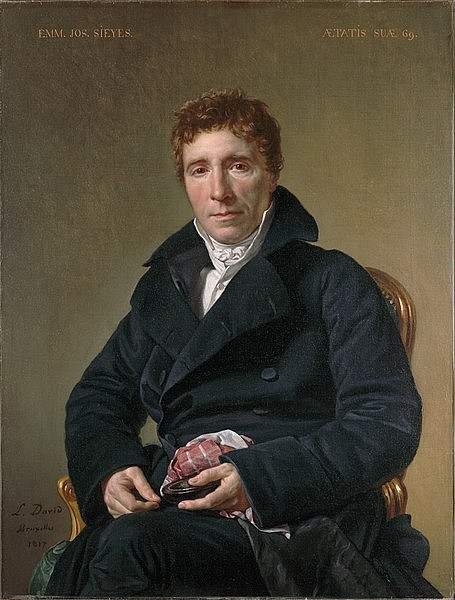
Emmanuel-Joseph Sieyès (1748-1836), commonly known as Abbé Sieyès, was a French clergyman and political writer, who became a leading voice in the Third Estate during the French Revolution (1789-99). Sieyès played instrumental roles in both the opening and closing events of the Revolution and sought a government that reflected the Third Estate, which he believed was the true nation.
Pre-Revolutionary Life
Emmanuel-Joseph Sieyès was born on 3 May 1748, in the town of Fréjus in the south of France. The fifth child of a local tax collector, Honoré, and his wife, Anne, Sieyès' family was by no means an affluent one, though Honoré was a landowner and had a modest income. As a child, Sieyès was privately educated by a Jesuit tutor, before attending the college of the Doctrinaires of Draguignan, with the goal of becoming a professional soldier. However, his poor health made this career choice impossible, so his parents decided he would be a priest instead. Young Emmanuel had no interest in such a life and was sent to Paris amidst "tears and protest" to be educated in theology and engineering at the seminary of Saint-Sulpice (Clapham, 4), where he would study for close to ten years before finishing his education at the college of Sorbonne.
Sieyès was not the model of a dutiful student, at least not where religion was concerned; indeed, at the end of his academic studies, his superiors remarked that he was, "by no means fitted for the ministry of the Church" (Clapham, 7). Neglecting his religious studies, Sieyès could often be found engrossed in works of philosophy, hoping to free himself from "every notion or sentiment of a superstitious nature" (Clapham, 7). Sieyès became fascinated by the works of Enlightenment political thinkers, particularly John Locke and Étienne Bonnot de Condillac. Rather than studying scripture, Sieyès read everything he could about the philosophy of representative government. By the time he finished his studies, he ranked at the bottom of his seminary class. Yet his self-education in political philosophy made him confident enough to boast to a friend, "politics is a science that I think I have mastered" (Scurr, 89).
Still, he was ordained as a priest in 1772 and found his first real job as a secretary to the bishop of Treguier three years later. He would find success in his career, becoming vicar general of Chartres in 1780, and later chancellor of the dioceses there. His spiritual profession made him no less cynical; he would later claim that it was this contrast between his career and personal opinions that inspired him to examine the composition of classes within society. While serving the bishop, he observed this firsthand at a meeting of the Estates of Brittany, noting the power wielded by the privileged orders. A commoner by birth, Sieyès came to sympathize with the lower orders, having come to the belief that they were carrying most of the societal burdens while the privileged classes of clergy and nobility leeched off their labor.
Sieyès was far from the only one to feel this way, especially in the late 1780s when failed harvest followed failed harvest, driving up the price of bread at a time when unemployment and inflation were already rampant. As the commoners struggled to survive, they also shouldered most of the tax burden, while the upper orders were mostly tax-exempt. These issues came to the forefront in 1787, when an attempt by the royal ministry to pass radical financial reforms led to a power struggle with the Parlement of Paris, resulting in the Revolt of the Parlements. This led to increased unrest across the country, as calls went up for the three estates of pre-revolutionary France to convene in an Estates-General, a representative body that had not met in 175 years.
Facing mounting pressure, King Louis XVI of France (r. 1774-1792) eventually obliged and ordered one to meet at Versailles in May 1789. Many in the Third Estate (commoners) rejoiced, realizing they could use this as a platform to lay their grievances before the nation. Yet, since no such assembly had been called since 1614, debates abounded as to how it should be organized. In late 1788, the king's chief minister, Jacques Necker, called on French writers to submit their thoughts on the issue. Many answered this call; none with as much vigor or influence as Abbé Sieyès, whose seminal pamphlet What is the Third Estate? was published in January 1789.
What is the Third Estate?
In his pamphlet, Sieyès asks and answers three questions (cited in the University of Oregon's translation):
- What is the Third Estate? Everything.
- What has it been until now within the political order? Nothing.
- What does it want to be? Something.
The pamphlet asserted that the Third Estate constituted a nation unto itself, by virtue of providing almost all of society's labor and taxes, and by comprising over 98 percent of the French population. The upper two estates, clergy and nobility, were nothing more than parasites, idle classes who provided nothing but burden; Sieyès likens them to malignant ulcers on the body of a dying man. For this reason, the Third Estate, which until now had been "nothing" in the political sense, needed to become "something", which Sieyès defines as being the least thing possible. He argues for three conditions that must be met in the upcoming Estates-General for the Third Estate to become "something":
- It must be allowed genuine representation elected from its own ranks.
- Its representation must be equal in number to the other two estates combined.
- Votes at the Estates-General must be counted by head, rather than by order for the Third's majority to truly be reflected.
Sieyès' pamphlet proved massively popular in the months preceding the Estates-General of 1789 and contributed to a radical shift in public opinion. By questioning the necessity of the privileged estates, Sieyès was attacking the foundations of the Ancien Régime itself, challenging conventional definitions of what the nation was and who was supposed to represent its interests. The idea of the Third Estate taking up the mantle of a 'national assembly' without regard for the other estates was also championed by Sieyès.
The Estates-General
Sieyès' pamphlet earned him the disdain of his own, clerical order, and it soon became clear that he would not be elected as a deputy of the First Estate. His admirers still wished to see him attend the meeting and urged him to run as a representative of the Third; this he did, winning election as the last Third Estate deputy to represent Paris on 20 May 1789. Five days later, he arrived in Versailles.
The Estates-General had been in session since 5 May, but so far it had gone nowhere. The Third Estate was refusing to call roll until it could be assured that the three orders would vote together, while the nobles were demanding the estates should vote in isolation, and the clergy was divided on the issue. Sieyès quickly made common cause with notable Third Estate leaders, such as Antoine Barnave and Honoré-Gabriel Riqueti, comte de Mirabeau, and attended meetings of the Breton Club, a gathering of Third Estate deputies who met to devise a concerted strategy. The Third Estate's plan of attack was almost certainly concocted here, and Sieyès was named its unofficial spokesman.
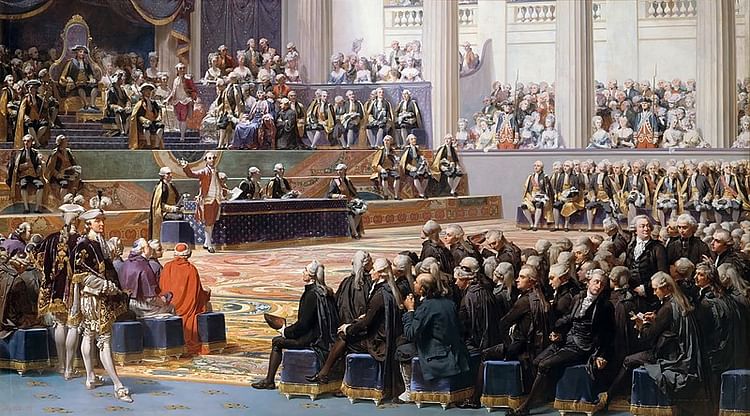
Had it not been for the name recognition, he would not have been the obvious choice; his frail, soft-spoken voice did not lend itself to extraordinary speechmaking, nor did his short, conceptually elaborate sentences. Yet none could doubt Sieyès' commitment, and on 10 June, he proposed that the Third Estate should wait a day for the other orders to join them, else they would begin proceedings on their own and vote without regard to the privileged orders. "Let us cut the cable," Sieyès allegedly said. "It is high time" (Clapham, 68). When no response came from the other estates, the Third Estate commenced rollcall.
On 13 June, three parish priests broke with their order to join the Third Estate. Over the next few days, more trickled over. Using the logic of his own What is the Third Estate?, Sieyès considered this to mean that the Third Estate had now assumed the power of the nation, and on 15 June, proposed that they reorganize themselves into an assembly called, "Assembly of the known and verified representatives of the French Nation" (Doyle, 104). This convoluted title was shortened to National Assembly, a title that was adopted on 17 June, the same day that the deputies declared all existing taxes to be illegal. The French Revolution had begun.
On 20 June, the First Estate voted to join the National Assembly, and deputies took the Tennis Court Oath, swearing not to disband until they had delivered a new constitution. King Louis XVI, who until now had dismissed the rumblings from the Third Estate as "only a phase", finally tried to put a stop to the Assembly, ordering all the estates back to their quarters on 23 June. Alongside Mirabeau's famous retort, Sieyès responded, albeit to a lesser effect, "Gentlemen, do you not feel that you are today all that you were yesterday?" (Clapham, 69). He urged his fellow deputies to stand their ground, which they did; four days later, Louis XVI relented and ordered the nobles who had held out to join the Assembly.
National Assembly & the Terror
After the Estates-General, Sieyès was recognized as one of the Assembly's most influential leaders. He worked on drafts of the Declaration of the Rights of Man and of the Citizen, a landmark human rights document, and played a major role in reorganizing France into 83 departments to make the election process easier. He advocated successfully for a unicameral legislative body and debated Mirabeau against allowing the king to have an absolute veto.
Yet, as early as autumn 1789, Sieyès found his influence starting to wane. On the night of 4 August, while both Sieyès and Mirabeau were away, the Assembly drafted the August Decrees in a state of patriotic frenzy. While the decrees abolished feudalism, they also promised the abolition of the tithe. Sieyès spoke out against the latter, not in defense of the clergy, but because he believed such an act would enrich property owners at the expense of the Church. In November, Sieyès also condemned the Assembly's confiscation of church properties, citing the right to property guaranteed by the Declaration of the Rights of Man. Once, Sieyès complained about the Assembly's actions while on a walk with Mirabeau, who quipped, "my dear Abbé, you have let loose the bull and now you complain that he gores you!" (Scurr, 103).
In Sieyès' mind, none of these actions could equal the catastrophe of the Civil Constitution of the Clergy, which subjected the French Catholic Church to the authority of the state, alienating many from the Revolution. To Sieyès, this was the Revolution's first major blunder; he said of his colleagues who supported the policy: "they wish to be free but they do not know how to be just" (Scurr, 119). Sieyès continued in the Assembly, his influence eclipsed by more dynamic men, until the Legislative Assembly in late 1791, which Sieyès was unable to be elected into. He reappeared in the third Assembly, the National Convention, which was established alongside the First French Republic in September 1792. Sieyès voted for the execution of Louis XVI and served on the constitutional committee, working under Marquis de Condorcet to craft what would become known as the Girondin constitution.
This constitution would never be voted on, however, for the Jacobins soon rose to power and passed their own. Sieyès disapproved of the Jacobin constitution but knew better than to admit it aloud; after Condorcet had attacked the Jacobin constitution, a warrant had gone out for his arrest. As the Reign of Terror covered France in its dark cloud, Sieyès learned to keep a low profile to avoid joining the ever-expanding list of his unfortunate colleagues who had met their end beneath the guillotine. He tried not to upset those in power and even renounced his faith during the height of the Revolution's de-Christianization and the rise of the Cult of Reason. Later, when asked what he had done during the Terror, Sieyès succinctly replied, "I survived."
Coup of Brumaire
After the downfall of Maximillien Robespierre in July 1794 and the subsequent Thermidorian Reaction, Sieyès returned to politics. The National Directory, which had replaced the Convention, crafted yet another constitution, which was adopted in 1795. Like every other constitution produced during the Revolution thus far, Sieyès disapproved of this one, too, to the extent that he refused to serve as a Director of the Republic. Instead, he tried his hand at diplomacy. In 1795, he helped draw up a treaty between France and the Batavian Republic, and in 1798, he skillfully, but unsuccessfully, negotiated for Prussia to join the War of the Second Coalition (1798-1802) on the French side.
Meanwhile, public opinion began to shift against the Directory. People were angry at the losses the French armies were suffering during the war. The Neo-Jacobins blamed corrupt contractors for keeping the Republic's armies undersupplied and blamed the Directors for enabling them. Sieyès sensed this discord to be an excellent time to return to power and try to bring about change; in May 1799, he was made a Director of France after the resignation of Jean-François Rewbell. A month later, Sieyès took advantage of the disunity within the Directory to coordinate the ousting of two other Directors; this coup of 30 Prairial left Sieyès as the dominant figure of government, a position he used to suppress the growing Jacobin resurgence. All that was left was to find some allies willing to help him dismantle the Directory and establish the constitution Sieyès had long dreamed of.
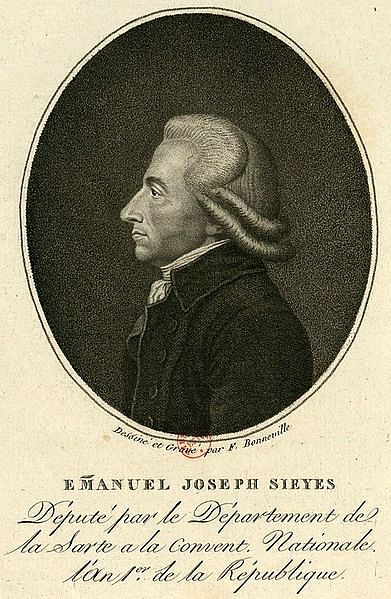
Sieyès quickly found allies for his conspiracy, namely Joseph Fouché, minister of police, and Charles-Maurice de Talleyrand-Périgord. Yet, if he hoped to stage a coup d'état, he would need a recognizable military name. He first made overtures to General Barthélemy Catherine Joubert, a rising star in the French army who had stood with Sieyès during the Coup of Prairial; Joubert’s death in August at the Battle of Novi thwarted this plan. He would not have to search long for the general's replacement, however, for in October 1799, General Napoleon Bonaparte (1769-1821) returned to Paris from his Egyptian campaign to find himself one of the most popular men in the city.
Sieyès met with Bonaparte, and the two took an almost immediate disliking to one another. Yet, each saw in the other a tool to achieve his own goal, and Bonaparte agreed to be the face of Sieyès' conspiracy. The coup was set for 9 November 1799, or 18 Brumaire Year VIII in the reckoning of the French Republican Calendar. Under the pretense of British-backed plots and Jacobin rebellion, Sieyès primed the Council of Elders (the Directory's upper legislative house) to grant Bonaparte command of all troops in Paris; that same day, Sieyès and fellow Directors Roger Ducos and Paul Barras resigned. The loss of three of the five Directors in a single day practically abolished the Directory and prevented a quorum from being reached. The remaining two Directors, both Neo-Jacobins, were arrested by Bonaparte's troops.
The following day, Bonaparte ran into some trouble in the Council of 500, the lower legislative house, as the deputies saw through the pretense. The coup might have ended in disaster right then, had it not been for the efforts of Bonaparte's brother, Lucien, president of the council, and for the presence of grenadiers loyal to Napoleon. In the end, the bloodless Coup of 18 Brumaire was a success; the Directory was dissolved, and a provisional government was set up, with Sieyès, Ducos, and Bonaparte named as provisional Consuls, in that order. This coup is largely considered to be the end of the Revolution.
Retirement & Death
Unfortunately for Sieyès, Bonaparte was not yet ready to put aside the business of coups. Sieyès, now seemingly at the height of political power, hurriedly went to work on a new constitution, one filled with checks and balances to centralized authority. Bonaparte did not see how this constitution could be better than the failed ones of 1791 and 1793 and moreover thought Sieyès to know "little of men's natures" (Roberts, 231). Immensely popular, Bonaparte was able to gather many powerful followers and was thereby able to outmaneuver Sieyès; when the Constitution of Year VIII was completed on 24 December 1799, it was very much Napoleon's constitution rather than Sieyès'.
Following this veritable coup within a coup, Sieyès was not entirely left out in the cold; he was given 350,000 francs in cash, an estate outside Versailles, and a house in Paris. After voicing his support for Napoleon as First Consul, Sieyès was appointed to the presidency of the Senate. He retired soon after, and largely refrained from politics during the period of the First French Empire. In 1815, during Napoleon's brief return to power during the Hundred Days, Sieyès was named to the Chamber of Peers.
He fled France in 1816 after the Bourbon Restoration; King Louis XVIII of France stripped him of his membership in the prestigious French Academy for his role in Louis XVI's execution. He lived a quiet life in Brussels for 14 years, returning to Paris only after the July Revolution of 1830. Sieyès died there six years later, on 20 June 1836, the 47th anniversary of the Tennis Court Oath, an event which had come about largely thanks to his influence. He was 88 years old.
